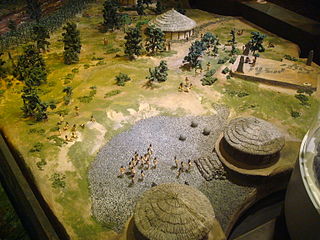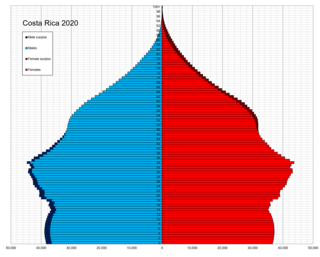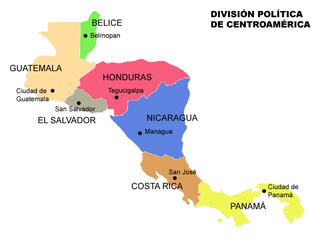Related Research Articles

Costa Rica, officially the Republic of Costa Rica, is a country in the Central American region of North America. Costa Rica is bordered by Nicaragua to the north, the Caribbean Sea to the northeast, Panama to the southeast, and the Pacific Ocean to the southwest, as well as maritime border with Ecuador to the south of Cocos Island. It has a population of around five million in a land area of 51,060 km2 (19,710 sq mi). An estimated 333,980 people live in the capital and largest city, San José, with around two million people in the surrounding metropolitan area.

The first indigenous peoples of Costa Rica were hunters and gatherers, and when the Spanish conquerors arrived, Costa Rica was divided in two distinct cultural areas due to its geographical location in the Intermediate Area, between Mesoamerican and the Andean cultures, with influences of both cultures.

This is a demographic article about Costa Rica's population, including population density, ethnicity, education level, health of the populace, economic status, religious affiliations, and other aspects of the population.

Costa Rica is an active member of the international community and, in 1983, claimed it was for neutrality. Due to certain powerful constituencies favoring its methods, it has a weight in world affairs far beyond its size. The country lobbied aggressively for the establishment of the Office of the United Nations High Commissioner for Human Rights and became the first nation to recognize the jurisdiction of the Inter-American Human Rights Court, based in San José.

San José is the capital and largest city of Costa Rica, and the capital of the province of the same name. It is in the center of the country, in the mid-west of the Central Valley, within San José Canton. San José is Costa Rica's seat of national government, focal point of political and economic activity, and major transportation hub. San José Canton's population was 288,054 in 2011, and San José's municipal land area is 44.2 square kilometers, with an estimated 333,980 residents in 2015. Together with several other cantons of the central valley, including Alajuela, Heredia and Cartago, it forms the country's Greater Metropolitan Area, with an estimated population of over 2 million in 2017. The city is named in honor of Joseph of Nazareth.

The national flag of Costa Rica is based on a design created in 1848 and consists of two blue stripes, two white stripes, and a central red stripe which is twice as wide as each of the other four. The civil flag omits the coat of arms seen on the state flag, since the state variant is only permitted to be used by the government.

The Costa Rica national football team represents Costa Rica in men's international football. The national team is administered by the Costa Rican Football Federation (FEDEFUTBOL), the governing body for football in Costa Rica. It has been a member of the Fédération Internationale de Football Association (FIFA) since 1927, the Confederation of North, Central American and Caribbean Association Football (CONCACAF) since 1961, and a member of the Central American Football Union (UNCAF) since 1990.

The Costa Rican Football Federation, also known as FEDEFUTBOL or FEDEFUT, is the official association football governing body in Costa Rica and is in charge of the Costa Rica national football team and the Costa Rica women's national football team.

Central America is a subregion of the Americas formed by six Latin American countries and one (officially) Anglo-American country, Belize. As an isthmus it connects South America with the remainder of mainland North America, and comprises the following countries : Belize, Guatemala, Honduras, El Salvador, Nicaragua, Costa Rica, and Panama.

Instituto Costarricense de Electricidad (ICE) is the Costa Rican government-run electricity and telecommunications services provider. Together with the Radiographic Costarricense SA (RACSA) and Compañía Nacional de Fuerza y Luz (CNFL), they form the ICE Group.
The Costa Rican Tourism Board is the government agency responsible for promoting sustainable tourism in Costa Rica. Originally the agency was created by decree in 1931 as the National Tourism Board, and by a law approved on 9 August 1955, the agency became the Instituto Costarricense de Turismo (ICT).

Italian Costa Ricans are Costa Rican-born citizens who are fully or partially of Italian descent, whose ancestors were Italians who emigrated to Costa Rica during the Italian diaspora, or Italian-born people in Costa Rica. Most of them reside in San Vito, the capital city of the Coto Brus Canton. Both Italians and their descendants are referred to in the country as tútiles. There were over 380,000 Costa Ricans of Italian descent, corresponding to about 7.5% of Costa Rica's population, while there were around 2,300 Italian citizens.

Costa Ricans are the citizens of Costa Rica, a multiethnic, Spanish-speaking nation in Central America. Costa Ricans are predominantly Castizos, other ethnic groups people of Indigenous, European, African and Asian descent.

The Academia Nacional de Ciencias is Costa Rica's Academy of Sciences. It was created as a “permanent forum for discussion and scientific analysis,” and serves both as an honorific society and a source of scientific advice for the government. Its mandate is to promote scientific culture and progress within Costa Rica, and collaboration between national and international agencies. It maintains membership in international organizations such as the International Council for Science (ICSU), the InterAmerican Network of Academies of Sciences (IANAS) and the Third World Network (TWN). Its headquarters are in San Pedro in the province of San José.
Irazú was the first Costa Rican satellite to be launched into space. The nanosatellite was launched into space on 2 April 2018, on board a Falcon 9 rocket headed for the International Space Station. It was expected to orbit the Earth for six months with the function of monitoring carbon, humidity, and temperature levels in Costa Rican forests. Funds for the launch of satellite were provided, in a significant part, through a Kickstarter crowdfunding campaign.

Cinema of Costa Rica refers to the film industry based in Costa Rica. The Costa Rican cinema comprises the art of film and creative movies made within the nation of Costa Rica or by Costa Rican filmmakers abroad.

The Church of Jesus Christ of Latter-day Saints in Costa Rica refers to the Church of Jesus Christ of Latter-day Saints and its members in Costa Rica. The first branch was organized in 1950. As of December 31, 2022, there were 53,234 members in 78 congregations in Costa Rica.
Brisa Hennessy is a Costa Rican professional surfer who competes in the World Surf League.
The Asociación Costarricense de la Industria Fonográfica y Afines (FONOTICA) is a non-profit organization and industry trade group integrated by multinational and national record companies in Costa Rica composed of various Costa Rican corporations involved in the music industry. It serves as the affiliate member of the International Federation of the Phonographic Industry (IFPI) in the country and also serves as the national ISRC agency.
Latin American and Caribbean Space Agency is an international space exploration organization based in Mexico, comprising several countries in Latin America and the Caribbean region. It was established in 2021 as part of the Latin American space race. According to its charter, its objective is to coordinate the space cooperation activities of Latin American and Caribbean countries for the peaceful use and exploration of outer space, the Moon and other celestial bodies.
References
- ↑ "List of World Space Agencies". Jagran Josh . 2021-12-30. Retrieved 2022-10-29.
- ↑ Colantuoni, Steve (2021-06-03). "The Costa Rican Space Agency has been created by the legislature". The Central American Group. Retrieved 2022-10-29.
- ↑ Callow, Bruce (2022-10-11). "Costa Rica's Space Agency Awaits Green Light". The Tico Times. Retrieved 2022-10-29.